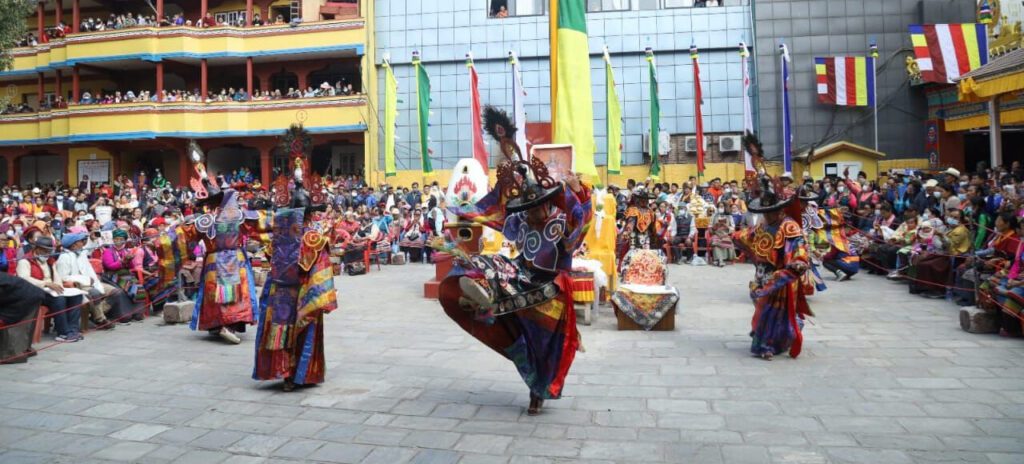Prayer flags are a common sight in Nepal and other parts of the Himalayan region. They are colorful rectangular flags inscribed with mantras, prayers, or sacred symbols, believed to bring peace, happiness, and good fortune to those who see them. In this blog post, we will explore the history and significance of prayer flags, where they originate from, the countries where they are commonly used, and the cultural and religious contexts in which they are used.
What are the prayer flags in the Himalayas?
The flags in the Himalayas are colorful rectangular flags that are often seen hanging outside homes, temples, and other religious sites. Each flag is inscribed with mantras, prayers, or sacred symbols, and is used to promote peace, compassion, strength, and wisdom.

When they are hung up, the wind carries the blessings and good wishes written on them into the world. A misconception is that the mantras are meant for the gods, nonetheless, they are meant to be blown into the world.
What do prayer flags mean?
Prayer flags are a traditional part of Tibetan and Nepalese culture, and they hold spiritual significance for many people. As mentioned before every flag is inscribed with mantras, prayers, or sacred symbols, they should be hung in the wind to carry out the blessings and good wishes written on them. They are believed to bring peace, happiness, and good fortune to those who see them.
Also Check: Food and Accommodation on Everest Base Camp Trek
Where are prayer flags from?
Prayer flags originate from Tibet, but they are also commonly used in Nepal, Bhutan, and other parts of the Himalayan region. The flags are associated with Tibetan Buddhism and are often used in religious ceremonies and rituals. However, they are also used by some Hindus in Nepal and other parts of the Himalayan region.
What do the colors of the prayer flags mean?
The colors of the flags are the five colors of Buddhism, which are blue, white, red, green, and yellow. These colors represent the five elements of earth, water, fire, air, and space, and are often used in Buddhist art and symbolism.
Blue means space. This color is used in meditation to transform anger into wisdom.
White means air. It is believed that this color can cut the delusion of ignorance and turn it into the wisdom of reality.
Yellow means earth. This color can transform pride into wisdom of sameness when used in meditation.
Green means water. The color green can turn jealousy into the wisdom of accomplishment.
Red means fire. Red is used in meditation to transform the delusion of attachment into the wisdom of discernment.
What is the story of prayer flags?
The origin of prayer flags is not clear, but they are believed to have been used in Tibet for over a thousand years. According to legend, a Tibetan prince named Lung Ta hung a flag on a mountain peak to symbolize his victory in battle. The flag was inscribed with mantras and prayers, and as the wind carried the flag’s blessings throughout the valley, the people began to use similar flags to spread good fortune and blessings.
What does the Nepal prayer flag mean?
The prayer flags in Nepal have the same beliefs of bringing peace, happiness, and good fortune to those who see them, as in Tibetan culture. They are a symbol of the rich cultural and spiritual heritage of Nepal.

What language are prayer flags?
The language used on prayer flags is usually Tibetan, but they can also be inscribed in Sanskrit or other languages depending on the region and tradition. In Nepal, prayer flags may be inscribed in Nepali or Tibetan, depending on the location and the people who use them.
Is it okay to have prayer flags?
Yes, it is okay to have prayer flags. They are a common sight in Nepal and other parts of the Himalayas, and many people hang them outside their homes or on religious sites. However, it’s important to treat the flags with respect and care, as they are considered sacred. You should not use them in clothing or throw them away. Furthermore, there are special days to hang the flags based on the Tibetan calendar.
When should I hang my prayer flag?
Prayer flags can be hung at any time of the year, there are certain times when considered especially to hang. In Nepal, the Himalayan region, it is common to hang during festivals, the Tibetan New Year, and Nepali New Year.

There is no specific rule or restriction on when to hang prayer flags, and individuals can choose to hang them. The most important thing is that you respect the cultural and spiritual significance of prayer flags.
Conclusion
In conclusion, flags are a beautiful and significant part of the cultural and spiritual heritage of Nepal. They are symbols of peace, goodwill, and prosperity and have been used for centuries to spread blessings and good wishes. Whether Hanging outside homes, temples, or other religious sites, flags continue to inspire and uplift people around the world. By understanding the meaning and history of flags, appreciate their beauty and significance and honor the rich cultural traditions.
Let our expert team at Asian Heritage Treks and Travel take care of everything — from guided tours to personalized packing tips and travel arrangements.
Plan an unforgettable journey







